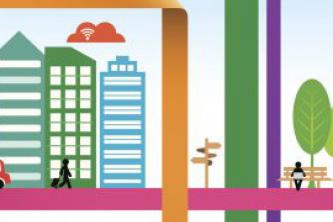
Corporate social responsibility, coworking and delocalisation place mobility at the heart of new corporate management practices. This research project examines the new practices surrounding corporate mobility management. Three case studies conducted by three researchers in the field of management science – Denis Chabault, Élodie Loubaresse and Bertrand Sergot – foster our understanding of these practises.
In Organizing Professional Mobilities, companies are understood and defined as “mobility regulators” just like states. How and to what extent do these companies organize our mobile lives? What implications can this regulation have for business leaders but also for their employees, suppliers or customers as well as for local or national governments? The term “mobility regulators” takes inspiration especially from John Urry and Tim Cresswell, who regard the state as a mobility regulator, using mobility to discriminate between those that are considered favorable to community interests and therefore deserve to be facilitated and those that are deviant or dysfunctional and therefore must be controlled or even prohibited. Companies produce differentiated mobilities according to scales, temporalities, social groups etc.
Thanks to the three fields of inquiry, this research program allows us to highlight several common lessons, which we present in the form of tensions.
The sense that mobility is something to be endured seems linked to the origin of the mobilities and the decisions related to them.
The second tension that emerges in this study focuses more specifically on the discrepancy between individual expectations in terms of spatial mobility and the daily or more exceptional reality of the company. Individual expectations in terms of spatial mobility are based on two main foundations:
The resulting discrepancies from these tensions are based on two dimensions:
Spatial mobility is also a source of tension between professional and private life. Work/private life tensions are everywhere in our case studies. They are expressed rather negatively and have an effect on several levels:
These tensions can also lead to a form of over-investment that is more specifically found in the axis devoted to teleworking. The absence of a clear spatial-temporal boundary between work and personal life leads individuals to work more.
The porosity, the permeability of borders but also their interconnections are often presented as advantages, thus encouraging the emergence of more decentralized, reactive and flexible organizations. The workplace then becomes a hybrid space, an in-between, both a professional place in which personal life makes intrusions, and conversely a personal living space that welcomes professional imperatives.
More specifically, some teleworkers have chosen to telework in order to take advantage of the beneficial aspects of having a new configuration in terms of professional/private life.
This last tension is referred to as an organizational stabilization/destabilization tension because it refers to the apprehension of companies as organized collectives built around standards, procedures and operating rules accepted by all, employees and/or managers, and oriented towards the achievement of common goals, i.e. the organizational goals.
Ensuring and maintaining the functioning of companies as organized collectives is not self-evident and requires constant work in order to stabilize its operation. The apparent stability of companies in space and time is therefore the result of a dynamic balance, a permanent tension between, on the one hand, forces promoting organizational stabilization and, on the other, forces pushing for organizational destabilization.
Our empirical data indicates that, in the three fields of inquiry, there is a potential for company destabilization associated with the employees’ spatial mobility and immobility. This potential for destabilization stems in particular from the employees’ sense of belonging to more or less organized collectives other than the company they work for.
Find the full summary by following this link (in French only)
Overall, the results of our research program show that the practices and representations of individual spatial mobilities (and immobilities) place companies in a state of permanent tension that always leaves the door open to the possibility of organizational destabilization or, in other words, to the possibility that the organized collective of the company will gradually unravel. The current context, that sees the decline of sedentary work and traditional shifts in favor of a greater spatial-temporal dispersion of professional practices, is increasing these risks of destabilization, questioning the usual operating procedures of companies and contributing to the emergence of new working collectives.
In light of our findings, we can outline some managerial recommendations:
Download the full report (in French only)
Download the summary of the results (in French only)
For the Mobile Lives Forum, mobility is understood as the process of how individuals travel across distances in order to deploy through time and space the activities that make up their lifestyles. These travel practices are embedded in socio-technical systems, produced by transport and communication industries and techniques, and by normative discourses on these practices, with considerable social, environmental and spatial impacts.
En savoir plus xThe remote performance of a salaried activity outside of the company’s premises, at home or in a third place during normal working hours and requiring access to telecommunication tools.
En savoir plus xPolicies
To cite this publication :
Bertrand Sergot et Denis Chabault (23 June 2014), « Expatriation, relocation and remote work: how do companies organize professional mobility? », Préparer la transition mobilitaire. Consulté le 09 May 2025, URL: https://forumviesmobiles.org/en/project/2454/expatriation-relocation-and-remote-work-how-do-companies-organize-professional-mobility

Projects by Forum Vies Mobiles are licensed under a Creative Commons Attribution-NonCommercial-ShareAlike 3.0 France License.
Permissions beyond the scope of this license may be available at contact.
Other publications